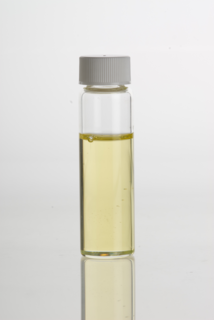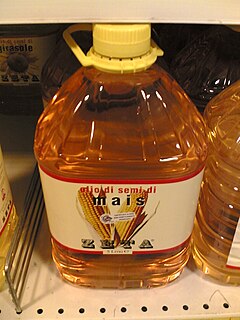Related Research Articles

A cereal is any grass cultivated for the edible components of its grain, composed of the endosperm, germ, and bran. Cereal grain crops are grown in greater quantities and provide more food energy worldwide than any other type of crop and are therefore staple crops. They include wheat, rye, oats, and barley. Edible grains from other plant families, such as buckwheat, quinoa and chia, are referred to as pseudocereals.

Quinoa is a flowering plant in the amaranth family. It is a herbaceous annual plant grown as a crop primarily for its edible seeds; the seeds are rich in protein, dietary fiber, B vitamins, and dietary minerals in amounts greater than in many grains. Quinoa is not a grass, but rather a pseudocereal botanically related to spinach and amaranth, and originated in the Andean region of northwestern South America. It was first used to feed livestock 5,200–7,000 years ago, and for human consumption 3,000–4,000 years ago in the Lake Titicaca basin of Peru and Bolivia.

alpha-Linolenic acid (ALA), also known as α-Linolenic acid, is an n−3, or omega-3, essential fatty acid. ALA is found in many seeds and oils, including flaxseed, walnuts, chia, hemp, and many common vegetable oils.

Hemp oil is oil obtained by pressing hemp seeds. Cold pressed, unrefined hemp oil is dark to clear light green in color, with a nutty flavor. The darker the color, the grassier the flavour. It should not be confused with hash oil, a tetrahydrocannabinol-containing oil made from the Cannabis flower.

Bran, also known as miller's bran, is the hard outer layers of cereal grain. It consists of the combined aleurone and pericarp. Corn (maize) bran also includes the pedicel. Along with germ, it is an integral part of whole grains, and is often produced as a byproduct of milling in the production of refined grains.

Omega-6 fatty acids are a family of polyunsaturated fatty acids that have in common a final carbon-carbon double bond in the n-6 position, that is, the sixth bond, counting from the methyl end.
Linoleic acid (LA) is an organic compound with the formula COOH(CH2)7CH=CHCH2CH=CH(CH2)4CH3. Both alkene groups are cis. It is a fatty acid sometimes denoted 18:2 (n-6) or 18:2 cis-9,12. A linoleate is a salt or ester of this acid.

Sesame oil is an edible vegetable oil derived from sesame seeds. The oil is one of the earliest-known crop-based oils. Worldwide mass modern production is limited due to the inefficient manual harvesting process required to extract the oil. Oil made from raw seeds, which may or may not be cold-pressed, is used as a cooking oil. Oil made from toasted seeds is used for its distinctive nutty aroma and taste, although it may be unsuitable for frying, which makes it taste burnt and bitter.

Chenopodium pallidicaule, known as cañihua, canihua or cañahua and also kaniwa, is a species of goosefoot, similar in character and uses to the closely related quinoa(Chenopodium quinoa).

Corn oil or maize oil (British) is oil extracted from the germ of corn (maize). Its main use is in cooking, where its high smoke point makes refined corn oil a valuable frying oil. It is also a key ingredient in some margarines. Corn oil is generally less expensive than most other types of vegetable oils.

Chia seeds are the edible seeds of Salvia hispanica, a flowering plant in the mint family (Lamiaceae) native to central and southern Mexico, or of the related Salvia columbariae of the southwestern United States and Mexico. Chia seeds are oval and gray with black and white spots, having a diameter around 2 millimetres (0.08 in). The seeds are hygroscopic, absorbing up to 12 times their weight in liquid when soaked and developing a mucilaginous coating that gives chia-based foods and beverages a distinctive gel texture.

Sunflower oil is the non-volatile oil pressed from the seeds of the sunflower. Sunflower oil is commonly used in food as a frying oil, and in cosmetic formulations as an emollient.

Pecan oil is an edible pressed oil extracted from the pecan nut. Pecan oil is neutral in flavor and takes on the flavor of whatever seasoning is being used with it. Pecan oil contains 9.5% saturated fat, which is less than in olive oil (13.5%), peanut oil (16.90%) or corn oil (12.70%). It is also used as a massage oil and in aromatherapy applications.

Chenopodium berlandieri, also known by the common names pitseed goosefoot, lamb's quarters, and huauzontle (Nahuatl) is an annual herbaceous plant in the family Amaranthaceae.

Cucumeropsis mannii is a species of melon native to tropical Africa west of the East African Rift, where it is grown for food and as a source of oil.

Chenopodium giganteum, also known as tree spinach, is an annual, upright many-branched shrub with a stem diameter of up to 5 cm at the base, that can grow to a height of up to 3 m.

A staple food, food staple, or simply a staple, is a food that is eaten often and in such quantities that it constitutes a dominant portion of a standard diet for a given person or group of people, supplying a large fraction of energy needs and generally forming a significant proportion of the intake of other nutrients as well. A staple food of a specific society may be eaten as often as every day or every meal, and most people live on a diet based on just a small number of food staples. Specific staples vary from place to place, but typically are inexpensive or readily available foods that supply one or more of the macronutrients and micronutrients needed for survival and health: carbohydrates, proteins, fats, minerals, and vitamins. Typical examples include tubers and roots, grains, legumes, and seeds. Among them, cereals, legumes, tubers, and roots account for about 90% of the world's food calories intake.

Cooking oil is plant, animal, or synthetic liquid fat used in frying, baking, and other types of cooking. It is also used in food preparation and flavoring not involving heat, such as salad dressings and bread dips, and may be called edible oil.
The Future 50 Foods report, subtitled "50 foods for healthier people and a healthier planet", was published in February 2019 by the World Wide Fund for Nature (WWF) and Knorr. It identifies 50 plant-based foods that can increase dietary nutritional value and reduce environmental impacts of the food supply, promoting sustainable global food systems.
References
- ↑ Railey, Karen. "Quinoa from the Andes" . Retrieved 7 November 2011.
- ↑ Quinoa ...: the next cinderella crop for Alberta?. Alberta Agriculture, Food and Rural Development. 2005. p. 9.
- ↑ Quinoa ...: the next cinderella crop for Alberta?. Alberta Agriculture, Food and Rural Development. 2005. p. 18.
- ↑ Koziol, M.J. (1993). "Quinoa: A potential new oil crop": 328–336.
{{cite journal}}: Cite journal requires|journal=(help) - ↑ Michael J. Koziol (1983). "Quinoa: A Potential New Oil Crop". New Crops Proceedings. 2: 328–336.
- 1 2 "The Scent Works" . Retrieved 7 November 2011.
- ↑ Ogungbenle, H. N. (2003). "Nutritional evaluation and functional properties of quinoa (Chenopodium". International Journal of Food Sciences and Nutrition. 54 (2): 153–158. doi:10.1080/0963748031000084106. PMID 12701372. S2CID 38284077.